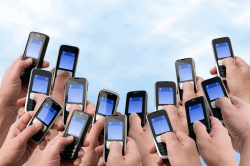Mobile marketing: the facts you need for 20122011-11-08 By: Kevin Bassett 3 Nov 2011 10:19
Five point three billion people have mobile phones. There are more people picking up a mobile phone every morning than those lifting a newspaper - and it's not only to make calls. Mobile data traffic is trebling every year. Super mobile devices, tablets and smartphones have outsold PCs, laptops and net-books, combined, this year. The world has moved to mobile, and it's different, so be prepared. Consumers demanding more mobile data services Voice communication is changing. The fractional cost of data transmission is, paradoxically, transforming the mobile phone into a data-only device. This is because traditional voice capability is being replaced by voice over Internet protocol (VOIP). VOIP companies have multiplied. A well-known VOIP company is Skype, with 170 million subscribers worldwide and 30 million mobile users. Skype was recently acquired by Microsoft for US$8.5 billion. Social media - and the desire to instantly share information - is driving mobile interaction. Twitter has 125 million mobile users generating 40% of all tweets. Facebook has 250 million mobile accounts and the recent uproar over Blackberry's hiccup, which didn't affect voice or SMS services, is evidence of users' reliance on data services. Video, however, is the fastest-growing area of the Internet. YouTube is uploading 48 hours of video per minute. American mobile watch-time is now 4 hours 20 minutes per month. It is estimated that, by 2015, two-thirds of the 6.3 exabytes crossing mobile networks will be video ('Mobile wave in a sea of digital change', Colin Knudsen, MD Coady Diemar Partners). Tech development pushing mobile growth As technology develops mobile capability, consumers benefit from the convenience and demand more bandwidth. Current technology development sees the simultaneous introduction of the speedy 4G networks by network operators, while programming is shifting to the mobile-friendly HTML5 language. These two developments will put mobile-user experience in line with traditional Internet delivery, albeit on a smaller screen. Also, the designers of mobile operating systems are continually improving the operating platform to maximise the commercial aspects of mobile connectivity. Apple, iOS, and Google Android are the dominant mobile operating systems, along with RIM, Windows 7 Mobile and others, which are all developed specifically for mobile devices. Apple and iOS are estimated to account for 55% of the smartphone market. They both dominate in the tablet market, which is predicted to grow by 250% this year. Commercial drivers of mobile Emerging commercial opportunities in the industry are vast. An example is the ability of mobile devices to be geographically located. Service providers now have the ability to communicate information and advertising based on the location of the device (location-based services). It's a threefold win when the consumer receives information relevant to his location, the advertiser gains a customer and the service provider earns a fee. International banks are developing a mobile-based transactional capability called Swipe to Pay, which is set to replace credit cards. This functionality is based on near field communication (NFC) technology. It allows an enabled mobile phone to be swiped past a merchant's reader to pay for goods. The technology uses the mobile device's unique radio frequency identification (RFID) to identify the owner to the banking institution, while the merchant simultaneously communicates the transaction details. Apart from the convenience for consumers and merchants, this technology will also reduce credit card fraud because customers' banking details are not available to the merchant. Further developments in mobile technology Quick response codes (QR codes) and Microsoft Tags are the product-code squares currently gaining traction in the retail market. Once scanned, these 2D barcodes can perform various functions. Typically they will open the phone's browser and display a webpage. You can expect to find the required 2D barcode readers as part of the original equipment on smartphones in 2012. Cloud computing is the upload and/or download option for storing information on remote computers via the Internet. It means handheld devices will no longer need to have a large memory capacity. The resulting release of processing power will allow for the development of new functionality, which will drive mobile personal-computing into a new era. Prepare yourself for the future Soon you'll be able to do the following: Communicate with customers via VOIP and video and voice over Internet protocol, on mobile phones. Advertise based on location, via video, on mobile Start using QR codes now, before the rush. Challenge your view on proprietary mobile apps and consider the advantages of mobile web-based HTML 5 apps. Now is the time to get comfortable with the idea that cloud computing will change everything. |
Mobile marketing: the facts you need for 2012
Copyright © 2024 KwaZulu-Natal Top Business
